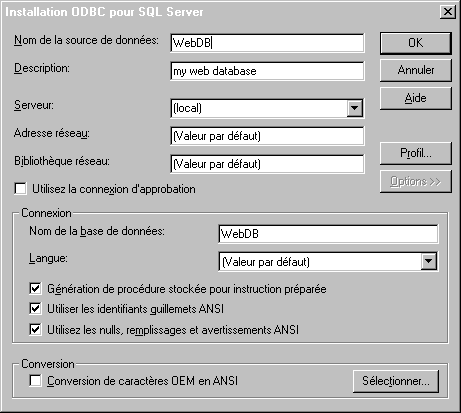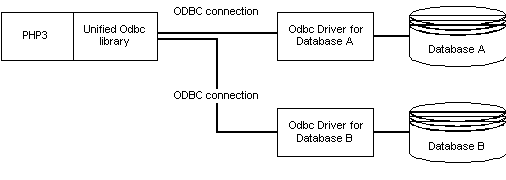
Fig 2 : ODBC configuration window
Open the ODBC tool in WinNT Control Panel . the icon looks like this : <img src="hlp_odbc_icon.gif" align=center>
Choose the "System DSN" panel.
Click on the Add... button
Choose the ODBC Driver you want to use. For example, if you want to connect on a MS-SQL Server base, choose "SQL Server"
Click on "Finish"
You should get a popup window like Fig 2.

Fig 2 : ODBC configuration window
Short explain about the fields:
Data Source Name (DSN) : this is the name to your ODBC connection. In our example, we'll use WebDB
Note : this is the ``dsn_name'' param given in odbc_connect()
Description : a comment about this connection
Server : indicate the IP address of the machine where the database server is. Use (local) if it stands on the same machine.
Click on Advanced button to enlarge the window.
Database name : The name of your base. In our example, we'll also use WebDB
On your Database Server, do the following:
login : webuser, password : [password]. In our example, we'll use ``webpassword''
Create a database named "WebDB"
In the Users/Groups section, make sure that the user webuser has an access to our DB ``WebDB''.
For this, use your DB Server Query Tool.
For this, use your DB Server Query Tool.
Grant the access on our table to our user webuser
Here is a php3 script to achieve this test. Save it for example in ``Apache\htdocs\test_odbc.php3''.
If you want to avoid permissions problems (common), you may use a Super-Admin access; have a look in the script.
From a web browser, try the script.
You should get a list of some french towns like this :
| id | nom |
|---|---|
| BO | Bordeaux |
| CL | Clermont-Ferrand |
| LI | Lille |
| LY | Lyon |
| MA | Marseille |
| NA | Nantes |
| PA | Paris |
| 7 entries | |
[ under construction, send your problems ]
ODBC Driver: Access User account does not have read permissions on the database file or write (or add) permissions on the directory where the script is run from.
ODBC Driver: Any
In the System DSN, you may have selected a SecurityDatabase.
=>You need to press the Advanced button and configure a username (UID) and a password (PWD) that are both valid and in the Security Database that you selected.
ODBC Driver: MS SQL Server
The user account does not have permissions to the database.
=> Have the Admin grant the proper permissions to the user account needing it.
ODBC Driver: MS SQL Server
This driver converts OEM character set to ANSI character set.
=> Unselect this option from the DSN's configuration window.

ODBC ( abbreviation of Open DataBase Connectivity) is a standard to access data sources. it defines a set of functions that must be implemented and identicals in ODBC driver (theory...)
Data sources can be a database, but also a text file, an Excel sheet...
The application must be able to send ODBC commands. In PHP3, the unified ODBC library provides a set of functions that are translated into ODBC commands.
Note: In the Win32 version, this library is by default compiled in php.exe
To access a database, the Database maker (or a third party) must provides an ODBC driver.
The benefit is that an application can access any data source with the same commands ( well, this is the theory...)
The DSN is the ODBC identifier. It is used to identify an ODBC Connection from another.
Most ODBC drivers also defines a username and password for security reasons. Current ODBC version is 3.0.
[Win32 Odbc FAQ] http://www.roth.net/odbc/odbcfaq.htm
This document written by Leo West - September 1998
Questions @ mailto:lwest@imaginet.fr